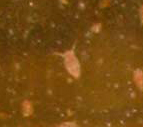by Frank Cowherd
Did you Know?

- Daphnia were originally called water fleas.
- Daphnia are found in swamp-like waters around the world.
- Daphnia are crustaceans, which means they have an exoskeleton like shrimp or crabs.
- Daphnia have more than 31,000 genes. People have fewer genes with around 21,000 genes.
- Under favorable conditions daphnia are all females and reproduce by asexual reproduction, producing young about every three days.
- Under non-ideal conditions daphnia reproduce sexually. At the first sign of favorable conditions going south, the next batch of baby daphnia produced are both male and female. Sexual reproduction produces a black egg case, containing a bunch of eggs, which takes about 8 days to hatch under the right conditions. If conditions are not right, the egg cases become dormant. Dormant eggs cases can survive heat and freezing and drying, which is how daphnia survive winters or droughts.
- Centuries old daphnia egg cases are often still viable and hatch under the right conditions. For example, egg cases from as long ago as the 12th century (1300 to 1650 AD) have been found to be good. Daphnia hatched from these old egg cases have been used in modern research studies for comparison with daphnia from recent times.
- Daphnia are a key species between the bacteria, algae, and protozoa they eat and the animals that eat daphnia.
- Daphnia are used as a way to monitor pollution in water. Daphnia are sensitive to any materials that get into their water through the sewer system or from farm runoff or put into their water on purpose. By placing materials into their water at various but known concentrations, the toxicity of the material can be determined. This method has been used by the government of the USA to specify the legal limits of materials in waters of the country. Countries around the world use similar methods.
Source: Chemical & Engineering News, p. 28, November 20, 2017
January 5, 2018
